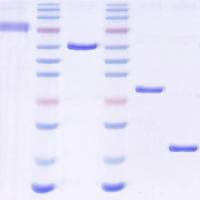Immobilization of Enzymes on Microelectrodes Using Chemical Crosslinking
互联网
524
Chemical crosslinking is perhaps the most commonly used method for immobilizing enzymes onto microelectrodes. It is rapid, simple to perform, and has wide applicability. It may be ideal for situations in which surfaces of a few hundred micrometers are to be modified. In principle, the procedure is simple: A drop of solution containing the enzyme to be immobilized, a bifunctional reagent, and frequently a lysine-rich auxiliary protein, such as bovine serum albumin (BSA), is placed over the microelectrode; the bifunctional reagent crosslinks the protein molecules together, finally leading to the formation of an insoluble gel. There are a number of bifunctional reagents that can be used, of which glutaraldehyde appears to be the most satisfactory (1 ). Although the procedure appears simple, the situation is in reality far more complex, stemming from the involved chemistry of glutaraldehyde (2 ,3 ), and care must be taken to ensure that reproducible results are obtained. In this chapter, we shall illustrate this technique with the immobilization of glucose oxidase in a gel of glucose oxidase and BSA.








